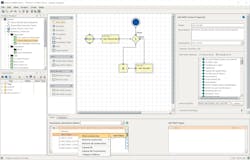Despite increasing signs of overlap between SCADA (supervisory control and data acquisition) and MES (manufacturing execution systems), the two automation mainstays are more likely to co-exist as a tightly knit couple rather than re-emerging as a single powerhouse manufacturing platform.
SCADA systems tend to the sub-second communications work of devices such as PLCs and sensors to monitor and control the nitty-gritty machinations of shop floor equipment and workflows. MESs operate at a higher level, serving as a control center for oversight of production scheduling, quality control, and traceability, among other critical operational aspects.
As a result, these systems have historically been siloed to target different aspects of the manufacturing spectrum. But their functions have started to coalesce. SCADA is being augmented with advanced functionality such as built-in intelligence, relational databases, and limited track-and-trace capabilities, and MES systems are taking a turn with real-time production monitoring and direct communications with growing and more sophisticated sensor networks.
Rather than one system enveloping all the functionality of the other or coming together as a consolidated replacement, experts say the platforms’ shared destiny is tighter integration and a blurring of the lines as manufacturers strive for that so-called “single pane of glass” that is the key to faster and more effective decision making.
“It’s not about MES vs. SCADA, it’s about what people are trying to achieve,” says Ranbir Saini, director of product management, automation software, at GE Digital. “That’s all about increased efficiency, reduction in costs, and making personnel more effective. To do so, requires a single pane of glass, especially with operators today more technically savvy and expecting a unified experience on a tablet.”
With the single pane of glass concept, plant floor operators, supervisors, and other manufacturing professionals can gain access to all the data they need about individual equipment assets, line performance, and top-line factory floor metrics in consolidated dashboards and visualizations as opposed to the siloed data points and myriad HMI screens of the past. “In the end, the MES or SCADA [debate] simply describes a set of capabilities that support interoperability and data exchange in a contextualized way so everyone can see all the data and make use of it for informed decision making,” Saini explains.
Two speeds of operation
As the missions of MES and SCADA merge around device data acquisition, visualization, and overlapping functionality, it raises the possibility for convergence. But there are reasons why a wholesale consolidation of MES and SCADA systems doesn’t make much sense. Viewing the systems through the lens of the ISA 95 or Purdue Model, a hierarchical structure for industrial communications, SCADA systems operate on Level Two, meaning a sub-second rate to exchange real-time, time-series data with PLCs and other low-level controls. MES, on the other hand, operates on a much lengthier time scale—as opposed to sub-second control data, MES serves as a transaction-based system, drawing on data in hours or sometimes even days and weeks.
Consider the real-world example of monitoring a batch tank. SCADA is monitoring temperature every second; if a change outside the range is detected, a course correction is initiated to bring temperature back in line. MES is also concerned about tank temperature, but from the point of view of whether the out-of-spec reading is cause for an exception that will ensure future quality control.
“The systems operate off a different time scale—SCADA is tied to time-series data like monitoring temperature at a very fast tempo to ensure safety and that everything is working properly,” explains Rashesh Mody, senior vice president and head of monitoring and control at Aveva. “When combining millisecond data with the larger timescale of MES transaction systems, it is more difficult [and] with a lot of coordination involved.”
The differences in speed also affects the protocols each system uses to interface with other systems. SCADA leans on industrial protocols like OPC, EtherNet/IP, and Modbus while MES supports a wider range of protocols because it needs to talk to SCADA and other business systems like ERP (enterprise resource planning) systems, typically using web services and other protocols through the protection of a firewall. Despite these differences, the argument for “flattening the stack” and consolidating platforms lies in the fact that both systems are pulling from the same data sources and thus could benefit from the opportunity to streamline the human interface, notes Sam Russem, director of smart manufacturing for Grantek, a systems integration firm.
“It can simplify the experience for operators and everyday users of the systems,” says Russem, explaining that, oftentimes, line operators in charge of running equipment need to interact with the production scheduling system to determine specific recipe instructions or tap into data that can help address equipment alarms. “In older systems, the scheduling happens in MES and the control of equipment in SCADA,” he adds. “The idea of having all that information presented to one person who needs it through a single interface makes the experience smoother.”
In fact, Grantek has worked with a manufacturer to integrate MES functions into a SCADA backbone to much success. By adding MES-like functions—like calling out to the ERP to pull down production orders and using that data to schedule orders on a line via SCADA—the manufacturer was able to reduce overall infrastructure costs while providing centralized data visualization for operators. “By designing SCADA screens with access to MES data or vice versa, there’s an opportunity to think about screens in ways you couldn’t have before and add value to what operators and planners are doing every day,” Russem says. “Part of the convergence story is breaking down data silos and data democratization.”
Recognizing the need for eliminating silos of data in manufacturing, providers of SCADA and MES software are adding features that blur the lines between the two platforms through tighter integration and an embrace of open standards. At Inductive Automation, the convergence of MES and SCADA is possible through the modularity of its Ignition server platform that leverages open technologies like OPC UA and MQTT to serve as a hub for plant floor resources. With this approach, Sepasoft’s MES modules can plug directly into Ignition as an add-on to address a variety of MES functions from a combined platform—for example, product genealogy, overall equipment effectiveness (OEE), downtime, statistical process control (SPC), recipes, and connection to an ERP system.
“Organizations are tired of having silos due to proprietary solutions, lack of integration options, and legacy pricing models,” says Travis Cox, co-director of sales engineering at Inductive Automation. “In the age of digital transformation or Industry 4.0, organizations want to bend the worlds of OT and IT, bring systems together, achieve greater access to data, and provide data to more people.”
The benefit of a “merged” platform is the single pane of glass, which allows operators to get SCADA and MES data on the same screen with a higher level of context, without having to toggle between disparate systems, Cox says. In addition, developing in a single, unified platform avoids the complexity of different development environments and mapping the same data to multiple places. “While Ignition provides integration with third-party MES or business solutions, it can be difficult to get the systems to work together without documented APIs (application programming interfaces) or open standards,” he explains. “With a unified development environment, you can solve challenges and build solutions faster. It also lays a foundation for the future…via the ability to expand the system.”
The notion of a “merged” MES/SCADA platform might work at the level of a single asset or even small manufacturing line, but in most instances the call is for fully featured, best-of-breed platforms that support a higher level of integration than what’s been delivered in the past, contends Aveva’s Mody. Key to the Aveva vision for higher-level integration is a model-driven architecture that bridges its System Platform SCADA and InTouch HMI platforms with MES and other enterprise software. The model-driven architecture allows modular MES applications to be deployed for greater extensibility and ease of customization along with the ability to define operational practices as digital workflows that can cut across applications.
Rockwell Automation has melded its core platform by adding some MES-like track-and-trace functionality at the SCADA level, but its real focus is on integration—albeit, integration of a different kind than a direct linkage of MES and SCADA. “In the past, integration would be a project; you’d take MES data and send it down to the SCADA level, but there were different data structures and a lot of transformation required,” explains Todd Montpas, a product manager in Rockwell’s MES business. “Now we’re making it simple and easy to do.” The simplification comes through “smart objects,” the construct for identifying discoverable data points and the data relationship model, which is now configured at the control level as part of the tag structure. This approach streamlines the integration process even before the machine sets foot on the plant floor, Montpas says.
Beyond higher-level integration between the two platforms, contextualization is another big part of the convergence story. GE addresses this via custom views and role-specific dashboards, which transform data from myriad platforms and resources into insights that drive better decision making. For DelmiaWorks, formally IQMS and now part of Dassault Systemes, adding SCADA-like capabilities such as real-time production process monitoring to its MES platform has been a priority, but the reality is SCADA systems aren’t going anywhere, so integrating and optimizing use of that data is central to a co-existence strategy. “Our platform from day one has been able to integrate SCADA data and continue to add value at the MES level by bringing greater adaptive and contextual intelligence into the data,” notes Louis Columbus, principal of DelmiaWorks and senior industry marketing manager at Dassault Systemes.
Even with siloed or blended replacement scenarios off the table, contextualization and integration efforts will continue to foster a more intelligent and productive partnership between SCADA and MES. “It’s not about one system replacing the other—it’s about sharing data both systems provide,” says Oliver Gruner, Iconics’ corporate account director at Mitsubishi Electric. “It’s using the best parts of both systems to turn data into information.”
Leaders relevant to this article:




